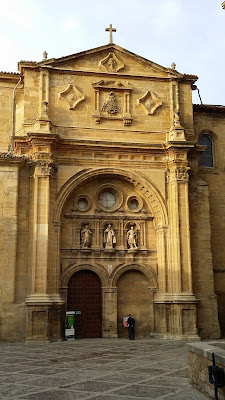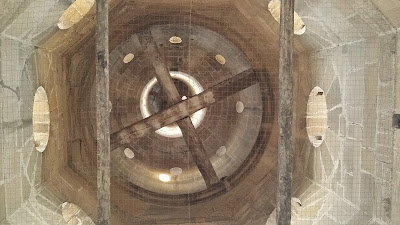The following morning we had a
hearty Continental breakfast of yoghurt, fruit, chorizo and bread at the Hospederia La Calera guesthouse, settled
the bill (which we thought at €25 each, was good value for the standard of
accommodation we had experienced) and made our way back over to San Millán de
Yuso. Part of the monastery complex has been turned into a hotel and beside it there
is a modern visitor’s centre and reception facing onto the external
courtyard where tickets for the guided tours of both monasteries can be
purchased.
 |
| San Millán de Suso |
The monastery of San Millán de
Suso is much smaller and more ancient than it’s grandiose younger brother Yuso.
Due to factors such as the age of the structure, it’s geographical location on
a hillside, the rainfall levels in the area, the vicissitudes of history (it was
burnt by Almanzor, Vizier and de facto ruler of El Andalus in 1002 and
sacked by the Black Prince, son of Edward III of England, who was an ally of
Pedro the Cruel, king of Castille, in the 1300’s) and neglect, the building has
been severely damaged and has required restoration and reinforcement. This has
meant that access is only with a tour guide in timed groups of about 20 people.
We booked on the 10:25 tour
and received a reduction on the ticket price due to being pilgrims with a
credencial. A small bus took us up the mountainside on a winding road through
mature deciduous woodland.
 |
| San Millán de Suso viewed from Yuso |
Arriving, the first thing
that struck me was the sense of tranquility. Standing still for a short time
and letting the other visitors in the group go on ahead, I was mesmerised by
the sound of birdsong, woodpeckers and sheep bells drifting through the
dripping trees. I could easily imagine San Millán and his band of followers
living here in the surrounding caves as hermits in the 6th Century. Originally,
before the monastery was built abutting onto the cliff face of a outcrop of rock, a natural crevice contained several caves which provided
shelter for a community of hermits who lived here in contemplation. These included
San Millán himself who was subsequently buried in one of the caves.
The tour guide brought me back
to reality from my reverie by shouting up the path at me. I don’t speak Spanish,
but a rough translation would probably be “stop hanging around daydreaming and
get inside the monastery with the other visitors or you will miss the tour!”
and indeed when I looked the other visitors had already gone through the outer
door! I ran up to the door, pushed it open and quickly joined them along with David,
who was already getting used to my dreamy detailed examinations of ancient
buildings!
I have visited ancient
Orthodox monasteries in Albania on several occasions and to my mind, the
monastery building itself reminded me much more of these than any monastery I
have visited in Western Europe before. It combines Visigothic (post-Roman and
pre-Arab invasions in A.D. 711), Mozarabic (Christians who lived under Muslim
rule) and Romanesque architectural elements. The square tower beside the
entrance gate with it’s overhanging eaves and tiled roofs is very picturesque
when viewed through the woodland.
 |
| View of San Millán de Yuso in valley below from Suso |
Stepping through the door I
found a cobbled verandah – like atrium with arched openings from which the
valley below could be viewed through the mist. The cobbling dates from
Visigothic times and the floor is lined with the tombs of the Seven Infants of
Lara with the tomb of their tutor, Don Nuño Salido.
 |
| Tombs of the Seven Infants of Lara and Don Nuño Salido |
The Legend of the Seven
Infants of Lara is told in a Spanish epic poem, which like the Chanson de
Roland mixes real events and people with wildly exaggerated myths. The “Seven
Infants” and their tutor Don Nuño Salido probably were real individuals who
lived in the 10th Century.
They were said to be the the
sons of Gonzalo Gustioz the Lord of
Salas (an area near Burgos). Reputedly of the blood of the Counts of Castille,
they were trained in Cavalry skills by Nuño Salido, and were said to be knighted
on the same day. They took part in the Reconquest
or wars against the Muslims in Southern Spain.
The theme of revenge runs through
the poem and at a wedding in Burgos in 986, one of the infants Gonzalez, the youngest of the seven
brothers, quarrels with and kills Alvar Sanchez the relative of the bride
called Doña Lambra. Her husband Ruy Velázquez Lord of Villaren, is persuaded
to avenge this offence and so Velázquez sends
Gonzalo Gustioz, a guest at the
wedding to Cordoba, capital of the Umayyad
Caliphate, unknowingly carrying a letter written in Arabic addressed to
Almanzor asking the Vizier to murder him. Almanzor however, does not murder
him, but imprisons him in Cordoba.
Meanwhile Velázquez pretends to make an incursion into Moorish territory accompanied
by the seven brothers and arranges for them to be ambushed. The seven infants and
Salido fight to the death and are
slain and their bodies beheaded. Their heads are displayed in Cordoba, (where a
street is still called the Street of Heads). Almanzor shows the heads to Gustioz who weeps when he recognises
them, and so Almanzor has pity on him and asks his sister to visit Gustioz and console him. She seems to do
this very effectively (!) because she gives birth to Gustioz’s son who is named Mudarra.
Mudarra is
raised in Cordoba and Gustioz is
released and returns to Salas. But when Mudarra
turns fourteen he goes in search of his father and learning of the
treachery of Velázquez he avenges the
death of his half-brothers by killing Ruy
Velázquez while he is on a hunting expedition, and then gathering together
a band of follower, he attacks the castle of Villaren, where Doña Lambra is captured, stoned and
burnt at the stake. Mudarra then
lives happily ever after as he is adopted by Gustioz’s and inherits his estate.
This story of revenge and
blood feud seemed strangely at odds with the peace and tranquillity of Suso,
but I suppose all human passion, hatred, ambition and strife is ultimately stilled
by death and the stone sarcophagi in the atrium spoke of this. Certainly the
epic conjures up well, the mixed loyalties of the Reconquest period given that,
for example, king Sancho the Strong married his sister to Almanzor and
Christians sometimes allied with the Muslims as the early
Spanish kingdoms struggled with each other as well as the Moors. To quote the
poem itself seems appropriate:
“Seven gentler boys, nor braver, were
never nursed in Spain,
And
blood of Moors, God rest your souls, ye shed on her like rain.”
This is not the only literary
association with Suso as according to tradition, the atrium is said to be the
spot where Gonzalo de Berceo, the 13th Century Benedictine monk,
wrote his poetry in the developing vernacular language of his time instead of in Latin,
thereby creating the earliest literature by a known author in Spanish. It was
also at Suso that the Glosa Emilianensis
was written.
 |
| Medieval Graffiti |
At the other end of the atrium
are the tombs of three queens of Navarre Doña
Toda, Doña Elvira and Doña Jimena dating
from the 10th and 11th Centuries. The walls of the atrium
are covered with graffiti written by pilgrims and monks in the 11th
and 12th Centuries.
Accessing the main building
through a Mozarabic doorway from the atrium, three different phases of
construction can be discerned although the construction at first seems quite complicated.
The first phase of building construction is in front of the original caves
where the hermits lived and has been built onto the original cliff face. It is Visigothic
and dates from the 6th and 7th Centuries.
 |
| Original Hermit's Caves |
The most westerly facing cave
contains bones from medieval burials, which can be seen in an alcove through a
modern glass window. These must be the burials of important people being sited
so close to the tomb of San Millán, but their names have been lost.
Beside this is the Oratory
Cave of San Millán where the saint was originally buried in A.D. 574. Although
his actual relics were removed to Yuso in 1030, a dark alabaster sepulchre was
placed in the cave in the 12th Century and is one of the oldest
statues in Spain. Beside this can be seen further caves
In front of the caves can be
seen the 10th Century Mozarabic monastery which was built in A.D.
959 with characteristic horseshoe shaped arches. This second part of the
building took advantage of some of the caves and is oriented to the south and
west. In 1002 Almanzor, burnt this part of the building and the original
monochrome decoration on the arches has been largely destroyed, though remnants
remain.
The third part of the building
was completed in the 11th and 12th Centuries when the
Benedictines arrived and lengthened the horseshoe arches with two further
Romanesque ones.
Other extensions to the
building have not survived and the building was finally abandoned in 1835 when
Mendizábal closed many religious houses including Yuso and Suso (although Yuso
was later given to the Augustinians).
Near the Ossuary cave can be
also be seen an unusual reliquary consisting of a blue tiled box attached to
one of the pillars which contains an ancient piece of wood. This relates to a
story about San Millán in which some workers were said to be building a barn when
they found that the timber they were going to use as a support was not the
right length. However, after San Millán had prayed, the timber was miraculously found to have lengthened in size and a left over piece of wood not
used for building was preserved in the reliquary!
The monastery of San Millán de
Suso is an interesting and atmospheric place evocative of so much Spanish and
Camino history and with added benefit of being in such a beautiful location.
David and I agreed that it our visit to San
Millán de la Cogolla had been well worth the effort involved in taking a detour
off the main Camino Francés route.





































































